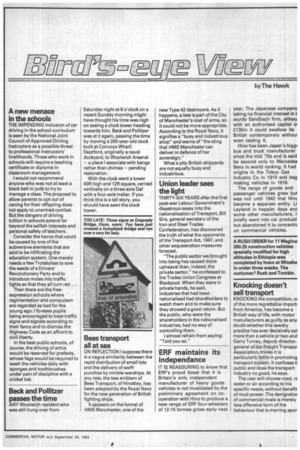A new menace in the schools
Page 83

If you've noticed an error in this article please click here to report it so we can fix it.
THE IMPENDING inclusion of car driving in the school curriculum is seen by the National Joint Council of Approved Driving Instructors as a possible threat to professional instructors' livelihoods. Those who work in schools will require a teaching certificate or diploma in classroom management.
I would not recommend anyone who was not at least a black belt in judo to try to manage a class. The proposal to allow parents to opt out of caning for their offspring does not apply to unarmed combat. But the dangers of driving tuition in schools extend far beyond the selfish interests and personal safety of teachers.
Consider the havoc that could be caused by one of the subversive elements that are said to be infiltrating the education system. One merely needs a few Trots kyites to sow the seeds of a Drivers' Revolutionary Party and to introduce moles into traffic lights so that they all turn red...
Then there are the freeexpression schools where regimentation and compulson are regarded as bad for the young ego. I foresee pupils being encouraged to treat traffic signs and signals according to their fancy and to dismiss the Highway Code as an affront to civil liberty.
In the best public schools, of course, the driving of artics would be reserved for prefects, whose fags would be required to wash the vehicles daily with sponges and toothbrushes under pain of discipline with a cricket bat.
Beck and Polliizer passes the time
ANY Woolwich resident who was still hung over from Saturday night at 8 o'clock on a recent Sunday morning might have thought his time was nigh on seeing a clock tower heading towards him. Beck and Pollitzer was at it again, passing the time by moving a 200-year-old clock built at Convoys Wharf, Deptford, originally a naval dockyard, to Woolwich Arsenal — a place I associate with bangs rather than chimes — pending restoration.
With the clock went a tower 43ft high and 12ft square, carried vertically on a three-axle Daf with a four-axle trailer. If you think this is a tall story, you should have seen the clock tower.
Bees transport all at sea
ON REFLECTION I suppose there is a vague similarity between the rapid distribution of small lots and the delivery of swift punches by nimble warships. At any rate, the bee emblem of Bees Transport, of Hinckley, has been adopted by the Royal Navy for the new generation of British fighting ships.
It appears on the funnel of HMS Manchester, one of the new Type 42 destroyers. As it happens, a bee is part of the City of Manchester's coat of arms, so it could not be more appropriate. According to the Royal Navy, it signifies a "busy and industrious shop" and warns of "the sting that HMS Manchester can • deliver in defence of her sovereign." What a pity British shipyards • are not equally busy and industrious.
Union leader sees the light
THIRTY-SIX YEARS after the first post-war Labour Government's disastrous essay into the nationalisation of Transport, Bill Sirs, general secretary of the Iron and Steel Trades Confederation, has discovered the truth of what the opponents of the Transport Act, 1947, and other sequestration measures forecast.
"The public sector we brought into being has caused more upheaval than, indeed, the private sector," he confessed to the Trades Union Congress at Blackpool. When they were in private hands, he said, industries that had been nationalised had shareholders to watch them and to make sure they showed a good return. But the public, who were the shareholders in the nationalised industries, had no way of controlling them.
I almost refrain from saying: "Told you so."
ERF maintains its independance
IT IS REASSURING to know that ERF's proud boast that it is Britain's only independent manufacturer of heavy goods vehicles is not invalidated by the preliminary agreement on cooperation with Nino to produce a new range of ERF four-wheelers of 12-15 tonnes gross early next
year. The Japanese company taking no financial interest in t sturdy Sandbach firm, althou with an authorised capital 01 £135m it could swallow its British contemporary withoei even tasting it,
Hino has been Japan's biggf bus and truck manufacturer since the mid '70s and is said be second only to Mercedes Benz in.world ranking. It had origins in the Tokyo Gas Industry Co in 1910 and beg making vehicles in 1916.
The range of goods and passenger vehicles grew but was not until 1942 that Hinc became a separate entity. Li Leyland in happier days and 'some other manufacturers, briefly went into car producti but abandoned it to concentri on commercial vehicles.
A RUSH ORDER for 11 Magirur 260.25 construction vehicles specially modified for high altitudes in Ethiopia was completed by Iveco at Win sfor in under three weeks. The customer? Rush and Tomkin.
Knocking doesn't sell transport
KNOCKING the competition, 01 of the more regrettable import: from America, has become a British way of life, with motor manufacturers as guilty as any doubt whether this tawdry practice has ever decisively sol more than a vehicle or two and Garry Turvey, deputy directorgeneral of the Freight Transpo: Association, thinks it is particularly futile in promoting transport system. It confuses tl public and does the transport industry no good, he says.
The user will choose road, ra water or air according to his specific needs, without benefit of mud-power. The denigratior of commercial rivals is merely less offensive form of the behaviour that is marring spar
























































































































